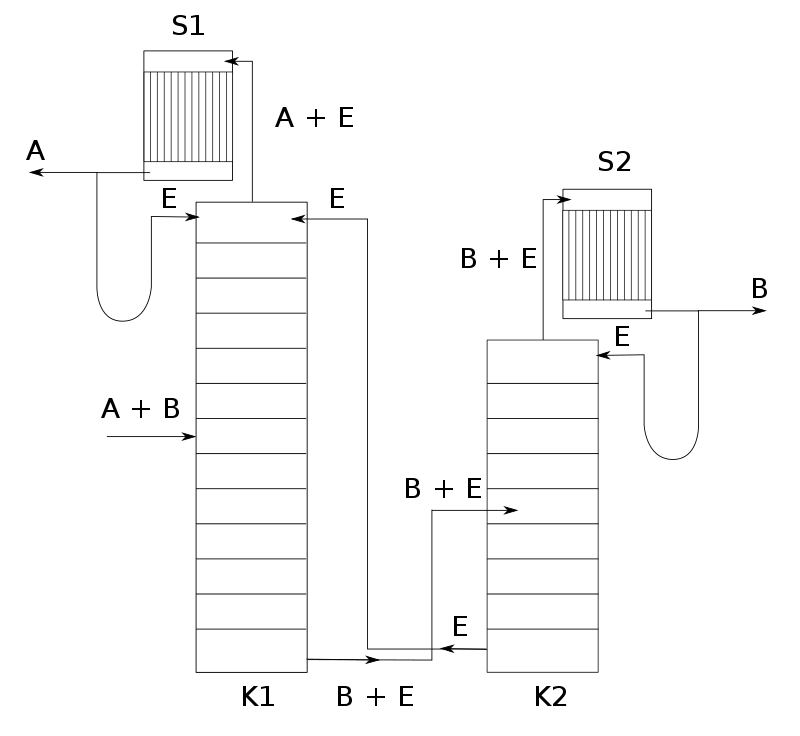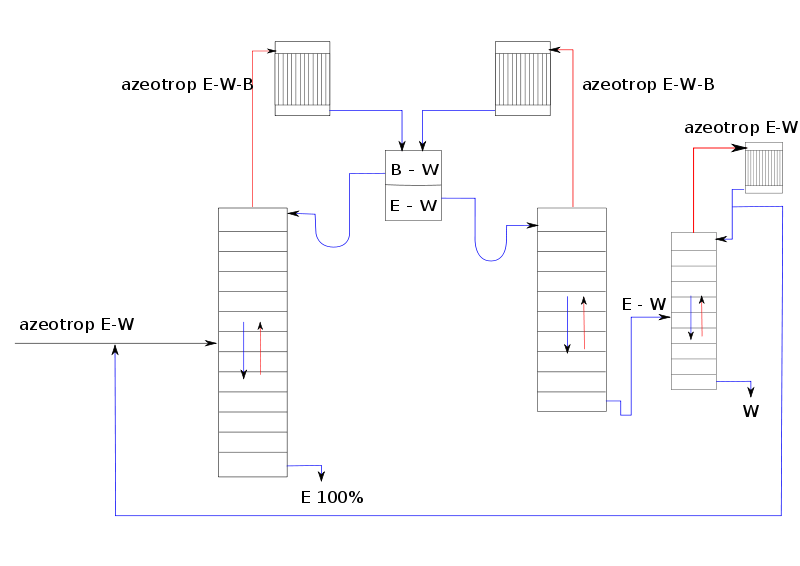Difference Between Azeotropic and Extractive Distillation
Key Difference – Azeotropic vs Extractive Distillation
The key difference between azeotropic and extractive distillation is that in azeotropic distillation, the formation of an azeotrope is required to separate the components of a mixture whereas, in extractive distillation, no azeotrope formation takes place.
Distillation is the process of purifying a liquid by a process of heating and cooling. In azeotropic distillation, an azeotrope is formed prior to the separation of components from a mixture. An azeotrope is a mixture of components having a constant boiling point. In extractive distillation process, there is no need to form an azeotrope. In that method, a third component is added to a binary mixture. This third component can affect the volatility of existing components.
CONTENTS
1. Overview and Key Difference
2. What is Azeotropic Distillation
3. What is Extractive Distillation
4. Side by Side Comparison – Azeotropic vs Extractive Distillation in Tabular Form
5. Summary
What is Azeotropic Distillation?
Azeotropic distillation is a separation technique used to separate the components of a mixture by forming an azeotrope. Azeotropes are component mixtures with a constant boiling point. This type of mixture cannot be separated into components by simple distillation since all the components have the same boiling point. When an azeotropic mixture is boiled, the proportion of components in the liquid and its vapor phase is equal.
In azeotropic distillation method, a new component (known as the entrainer) is added to the azeotropic mixture in order to form a new azeotrope that boils at a lower temperature than the existing azeotrope. Then the system has two immiscible liquid phases with different boiling points (heterogeneous).

Figure 01: The System of Separating Ethanol (E) from water (W) using Benzene (B)
For example, let us consider a mixture of ethanol and water. It is known as a binary azeotrope because there are two miscible components in the mixture. If benzene is added as the entrainer to this mixture, it can affect the volatility of other components in the mixture. The mixture is now called tertiary azeotrope since there are three components in the mixture. When this mixture is distilled, it is known as azeotropic distillation.
What is Extractive Distillation?
Extractive distillation is a separation technique that includes the addition of a third component to a binary mixture to permit the separation of the two components. However, the third component does not vaporize during the distillation process; the third component should be less volatile. Or else, it should have a higher boiling point.
If the binary mixture has two components with relatively similar boiling points, then these components cannot be separated by simple distillation. This happens since both components will be vaporized at nearly similar temperatures (poor resolution).

Figure 02: A System Showing the Extractive Distillation of A and B Mixture using E Solvent
During the extractive distillation process, an azeotrope is not formed. The process involves a solvent with a very low volatility as the solvent of the component mixture. It is known as the separation solvent. During the distillation, the component with highest volatility will be vaporized easily as the top product. The remainder is the solvent and the other component (in the binary mixture). Since the solvent does not form an azeotrope with the second component, it can also be separated easily with an available method.
For example, extraction of toluene from paraffin can be done in extractive distillation method. The mixture of toluene and iso-octane have nearly similar molecular weights. Therefore, the separation of toluene out of this mixture is very difficult. But when phenol is added to this mixture, the boiling point of iso-octane increases. This makes it easy to separate toluene from this mixture.
What is the Difference Between Azeotropic and Extractive Distillation?
Azeotropic vs Extractive Distillation | |
| Azeotropic distillation is a separation technique used to separate the components of a mixture by forming an azeotrope. | Extractive distillation is a separation technique that includes the addition of a third component to a binary mixture to permit the separation of the two components. |
| Technique | |
| In azeotropic distillation technique, the formation of an azeotrope prior to the distillation is important. | In extractive distillation technique, a non-volatile component is added to the mixture that can affect the volatility of components in the mixture. |
| Separation | |
| Azeotropic distillation separates a component into the vapor phase which has the same chemical composition as in the liquid phase. | Extractive distillation separates a component from a matrix of substances. |
Summary – Azeotropic vs Extractive Distillation
Distillation is a chemical technique used for the separation of different components in a mixture. There are many types of distillation techniques, simple distillation being the simplest type. Azeotropic distillation and extractive distillation are two important types of distillation. The difference between azeotropic and extractive distillation is that the formation of an azeotrope is required to separate the components of a mixture whereas, in extractive distillation, no azeotrope formation takes place.
Reference:
1. “Azeotropic Distillation.” Wikipedia, Wikimedia Foundation, 4 Apr. 2018. Available here
2. “Extractive Distillation.” Wikipedia, Wikimedia Foundation, 14 Jan. 2018. Available here
3. “Azeotrope.” Wikipedia, Wikimedia Foundation, 8 Apr. 2018. Available here
Image Courtesy:
1.’Distil extract’By Joanna Kośmider – Own work, (Public Domain) via Commons Wikimedia
2.’Azeotr distill2’By Joanna Kośmider – Own work, (Public Domain) via Commons Wikimedia
ncG1vNJzZmivp6x7pbXFn5yrnZ6YsqOx07CcnqZemLyue8OinZ%2Bdopq7pLGMm5ytr5Wau26t2Z6mraqfpbakecCnm2auo2KyucDRmpqtoaaaeqW10q2gpaSRqbawuo4%3D